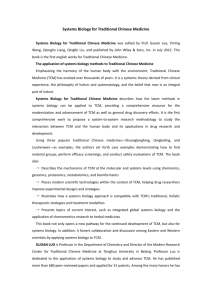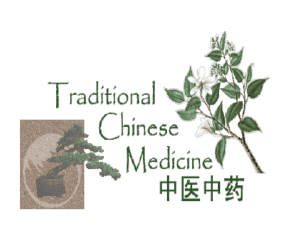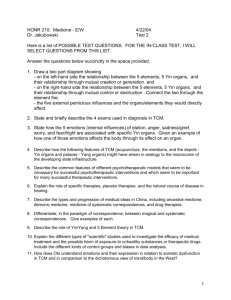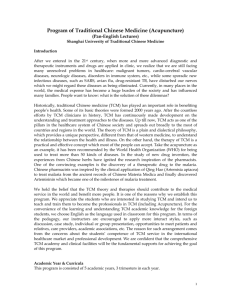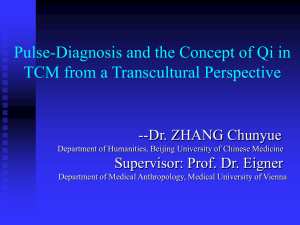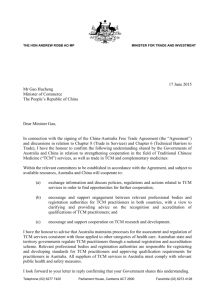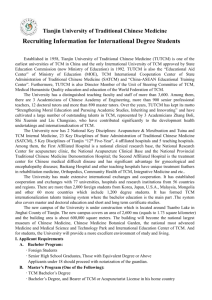中医经典名词术语英译
advertisement
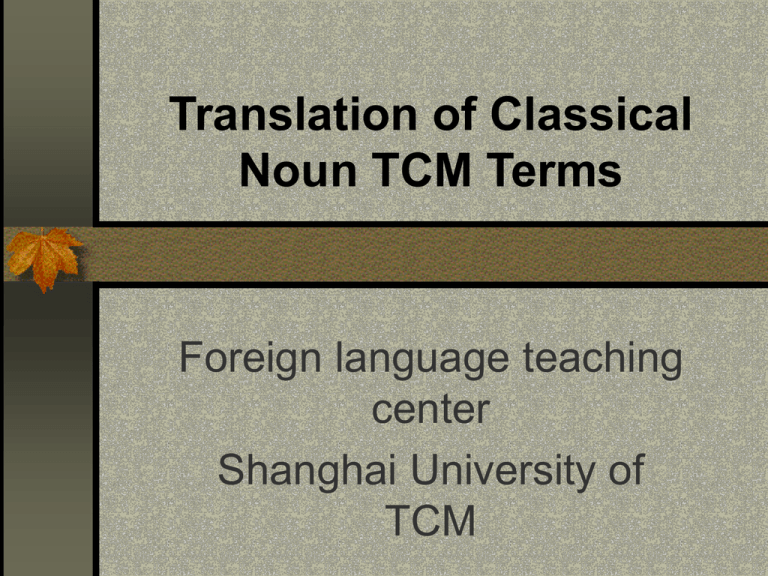
Translation of Classical Noun TCM Terms Foreign language teaching center Shanghai University of TCM Overview of Classical Noun TCM Terms Unit one Learning Objectives 了解“阴阳”、“五行”等中医经典名 词术语的医学内涵。 掌握与西医术语的差异,理解中医的思 维模式,熟悉中医经典名词术语与现代 医学术语的差异。 掌握中医经典名词术语翻译的原则与方 法。 由于中西方医学是在两种完全不同的文 化背景下发展起来的,因此部分中医名 词术语代表的完全是中医特有概念,很 难在英文中找到对应词或等价物,在翻 译时只能采用音译的方法,需要是加上 必要的英文解释。例如中医的“阴”、 “阳”等。 yin: a philosophical term in ancient China, referring to things or characters opposite to yang. The condition which appears as inert, internal, downward, cold, dim, material, inhibitive, and declining is attributive to yin. In TCM, it is widely used for explaining the physiological and pathological phenomena of human body, and for directing the diagnosis and treatment of the disease, for example, interior-syndrome are ascribed to yin. yang: a philosophical term in ancient China, referring to things or characters opposite to yin. The condition which appears as active, external, upward, hot, bright, functional, exciting, and hyperactive is attributive to yang. In TCM, it is widely used for explaining the physiological and pathological phenomena of human body, and for directing the diagnosis and treatment of the disease, for example, superficies-syndrome, heat-syndrome, sthenia-syndrome are ascribed to yang. 同样属于此类的中医经典名词术语还有 以下几个: 气 qi 神 shen 命门 mingmen 三焦 sanjiao Classical Noun TCM Terms on Five-organs and diseases Unit Two 中医有一些器官名称术语,这些名词术语与西医器官 相比,大部分所指代内容基本相同,因此在翻译时完 全可以借助于西医术语进行英译,例如: 肝 liver 心 heart 脾 spleen 肺 lung 肾 kidney 手 hand 脚 foot 四肢 extremities 关节 joint 此外,由于疾病属于客观存在物,不管人们如何称呼 它,它总是客观存在的。所以,中西医在疾病名称方 面,也有部分情况时完全对应的,在翻译这些术语时, 也可以借助西医术语进行英译,例如: 感冒 cold 梅毒 syphilis 疟疾 malaria 白喉 diphtheria 麻疹 measles 黄疸 jaundice 便秘 constipation 呃逆 hiccup Classical Noun TCM Terms on “经络” Unit Three “经络”是中医中重要的术语,目前对于其英译主要有 meridian与channel两种。要探究究竟哪种译法更贴切, 我们需要从其内涵开始探讨: Meridian指a great circle of the celestial sphere passing through its poles and the zenith of a given place. 而Channel则指a usually tubular enclosed passage : conduit.从解释上可以看出meridian最初指经线;而 channel则指 通道/渠道之意。中医上的经络是指气血 运行的通道,从这个意义上讲channel更符合中医五行 的概念。 Translation Exercises Unit Four I. Translate the following terms and expressions into English: 1.六淫 2.七情 3.五行 4.津液 5.营血 6.肝火 II. Translate the following sentences into Chinese. 1. 阴阳的对立消长是宇宙的基本规律 2. 阴阳相对平衡的破坏就会导致阴或阳 的偏盛或偏衰。 3. 相生是指一事物对另一事物有促进、 助长和资生的作用。 4. 相乘和相侮是不正常的相克现象。 5. 五脏与形体诸窍连成一个整体。 III. Translate the following passage into Chinese. The concept of yin-yang is probably the single most important and instinctive theory of Chinese medicine. It could be said that all Chinese medical physiology, pathology and treatment can, eventually, be reduced to yinyang. The concept of yin-yang is extremely simple, yet very profound. One can seemingly understand it on a rational level, and yet, continually find new expressions of it in clinical practice and , in deed, in life. Translation of Classical Verbal TCM Terms Unit Five Learning Objectives 了解中医经典动词术语的医学内涵, 分析其语法结构特点与内部逻辑结 构。 理解中医的思维模式,熟练掌握各 种结构中医经典动词术语翻译的方 法。 1. 掌握中医经典动词术语的内部结构,并掌 握其英译的方法,如:主谓结构(胞衣不下)、 主谓宾结构(表邪入里)等,如主谓宾结构术 语可以用主语+动词ing形式+宾语的形式来翻 译,如“表邪入里”译为exterior pathogen entering the interior;“肝气犯胃”译为liver qi invading stomach,“入”和“犯”各用 “enter”和“invade”的动词ing形式翻译,并 在前后加上主语和宾语。 中医经典动词术语应以过程中除须注意其 语法结构外, 同时还要注意术语内部的逻辑关系,如目的关 系,因果关系,并列关系,转折关系等。以目 的关系为例,可以用英文介词to或者for来表示。 如 “ 护 肝 明 目 ” 译 为 reinforcing the liver’s function to improve the acuity of sight;“活 血 调 经 ” 译 为 promoting blood flow for regulating menstruation。 2. Syntactic Structure of Classical Verbal TCM Terms Unit Six 中医经典动词术语语法结构分类 及其英译: 主谓结构术语的翻译:根据英语多用名词词组的特点, 主谓结构术语可以翻译成英语的名词词组。如:“胞 衣不下”译为retention of placenta;“大便滑脱”译 为incontinence of feces,这两个术语没有将“不下”、 “滑脱”用相应的英语动词翻译,而是用名词+of+主 语的形式来翻译。另外,“肌肤甲错”译为squamous and dry skin;“面色苍白”译为pale complexion,考 虑到“甲错”、“苍白”既可视为谓语,但其含义也 是修饰主语,所以这两个术语可采用形容词加名词的 翻译方法。 主谓宾结构术语的翻译:主谓宾结构术 语可以用主语+动词ing形式+宾语的形式 来翻译,如“表邪入里”译为exterior pathogen entering the interior; “肝气犯胃”译为liver qi invading stomach,“入”和“犯”各用“enter” 和“invade”的动词ing形式翻译,并在 前后加上主语和宾语。 动宾结构术语的翻译:动宾结构术语可 以用动词+ing的形式后接宾语来翻译。 如:“补益心气”译为benefiting heart qi;“调和气血”译为 harmonizing qi and blood,“补益” 和“调和”分别用“benefit”和 “harmonize”翻译,并取ing形式,再加 上相应的宾语。 述补结构术语的翻译:述补结构是指动词担任 述语,并有补语对其进行修饰、补充,如“平 素自汗”中“自汗”作述语,由“平素”对其 进行修饰。翻译时可译成名词词组或动词ing 形式的词组 +副词的形式,如:“平素自汗” 译为usually spontaneous perspiration; “常易感冒”译为often catching cold, “自汗”和“感冒”各用了名词词组 “spontaneous perspiration”和动词ing词组 “catching cold”,然后用副词“usually”和 “often”来修饰。 联合术语的翻译:联合的四字格术语一 般可用动词(ing)+名词+and+动词 (ing)+名词的形式来翻译,如:“补 火壮阳”译为reinforcing fire and strengthening yang;“补脾健胃”译 为supplement the spleen and fortify the stomach,这两个术语的两个动宾结 构都分别翻译出,并在中间加上and连接。 Inner Logic Structure of Classical Verbal TCM Terms Unit Seven 中医经典动词术语内部逻辑结构分类及其英译 目的关系:如“护肝明目”译为 reinforcing the liver’s function to improve the acuity of sight,用to引导出 目的状语,表示“护肝”的目的是为了 “明目”。而“活血调经”被译为 promoting blood flow for regulating menstruation,其中用介词for+动词ing 词组,也可表明目的关系。 因 果 关系 : 如“肾虚水泛”译为water diffusion due to kidney deficiency,用 “due to”表示“水泛”是由于“肾虚” 的原因。又如“胞寒不孕”译为sterility due to uterine cold,同样用到“due to” 表示因果关系。 并 列 关 系 : 如 “ 清 肺 养 阴 ” 译 为 nourishing the lung and preserving its yin essence,用连接词and表现了并列 关系。 转折关系:如“补而不滞”译为 supplement without causing stagnation, 用without引出“补”却不会发生“阻滞” 的结果。 Translation Exercises Unit Eight I. Translate the following terms and expressions into English: 1. 2. 3. 4. 5. 6. 7. 8. 9. 10. 淡渗利湿 扶正祛邪 养血柔肝 燥湿化痰 固表止汗 活血化瘀 敛肺止咳 清热化痰 软坚散结 润肺化痰 II. Translate the following sentences into Chinese. 养阴清热适用于热病后期阴虚火旺的 证候。 2. 表邪入里为病进,里邪出表为病退。 3. 热结肠胃则腹胀满痛拒按,大便秘结。 4. 肝风内动是体内阳气亢逆变动而形成 的一种病理状态。 5. 补气健脾适宜于治疗脾气虚弱证。 1. III. Translate the following passage into Chinese. After making a diagnosis and identifying the pattern, the next logical step is that of determining the principle of treatment to be adopted. The practitioner of Chinese medicine will need formulate a rational and coherent plan of action as to what should be treated first, what is primary and what is secondary in patient’s condition, what is the relative importance of the acute or chronic condition and what method of treatment should be used. English words’choice of Classical Verbal TCM Terms Unit Nine 中医经典动词术语英译选词处 理: “化”字是中医文献或中医术语中常用的汉字,可出现在 中医药学的阴阳五行、气血津液、藏象、经络、病因 病机、治法与方剂等学说或学科中。含“化”字的中 医术语数以百计,不胜枚举,如“制化”、“从化”、 “阴阳转化”、“肝阳化风”、“芳香化湿”等等。 目 前 关 于 “ 化 ” 字 的 英 译 , 就 有 cause 、 change 、 convert 、 digest 、 digest 、 dispel 、 dissipate 、 dyspepsia 、 eliminate 、 form 、 generate 、 relieve 、 remove、resolve、transform、transport等多种译法。 但并不是所有选词都合适,应该进行必要的筛选,筛 选时应根据动词的词义择优选择。“化”字在中医中 主要有以下意思; “化”字在中医中主要意思: 相当于“产生、形成”,可选用为generate或cause。 查Merriam-Webster词典知,generate指to bring into existence,其后宾语常为正常生理物质,而 cause系指to serve as a cause,具“引起”之意, 其后宾语可为病理产物,故前者可用于生理性术语而 后者可用于病理性术语。例如:“制化”之“化”有 “产生、形成”之意,可译为restriction and generation;而“化风”、“化火”可译为cause wind与cause fire。相比之下,change与convert也指 变化,但前者指“一般变化”,后者指“根本改变”, 二者均无“产生”之意;而form释义为to serve to make up or constitute,主意为“构成”,与“化” 之“生”意有所差异。 “化”字在中医中主要意思: 相当于“性质或形态改变”,可选用 transform。Merriam-Webster词典transform 解释为 to change in composition or structure 与to change the outward form or appearance,与“化”的此义吻合,故可 采用之,例如“肝阳化风”可译为liver yang being transformed into wind。而英文中 transport系指to transfer or convey from one place to another,只有“运输”之意而 无“状态改变”之意,故此译不取transport 而取transform。 “化”字在中医中主要意思: 相当于“去除,消除”,可选用eliminate、remove、 resolve。前者侧重于去除抽象物质(如eliminate poverty),中者重于去除实质性物质(如remove a tumor),而后者重于通过分解而逐步解决(to change by disintegration 或者to reduce by analysis)。如“化湿”可译为to eliminate dampness、“消食化滞”可译为promoting digestion to remove food stasis、“化痰” 可译为to resolve phlegm。对比之下,dispel系指to drive away by or as if by scattering,重于驱散; dissipate系指to break up and drive off(as a crowd)或 to cause to spread thin or scatter and gradually vanish,重于扩散;relieve指减缓、 减轻,而无“消除”之意,与“消除”之意均有所差 “化”字在中医中主要意思: 相当于“消化”:可选用digest,例如 “完谷不化”翻译为diarrhea with undigested food。 Translation Exercises Unit Ten I. Translate the following terms and expressions into English: 1. 2. 3. 4. 5. 6. 7. 8. 9. 10. 少阴寒化 润燥化痰 芳香化浊 少阴热化 温化寒痰 阴阳转化 活血化瘀 肝阳化风 五志化火 芳香化湿 II. Translate the following sentences into Chinese. 1. 饮食不节主要损伤脾胃,导致脾胃功能失常。 2. 经脉中的气血运行循环灌注,如环无端。 3. 津液停滞导致气机不利,则称作水停气滞。 4. 气流行于全身而推动和激发着人体的各种胜 利功能。 5. 气机郁结会导致血液运行及津液输布代谢 的障碍。 III. Translate the following passage into Chinese. Formulas in Chinese medicine are not mere collections of medicinal substances in which the actions of one herb are simply added to those of another in a cumulative fashion. They are complex recipes of interrelated substances, each of which affects the actions of the others in formula. It is this complex interaction that makes the formulas so effective, but also makes them difficult to study. Discussion “补”目前就有 “invigorating”、 “replenishing”、“strengthening”、 “nourishing”、“benefiting”、 “supplementing”、“recuperating”、 “enriching”、“tonifying”、“boosting” 等多种译法,哪几种译法比较恰当。 Thank You!
